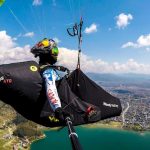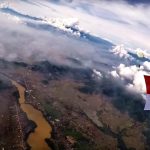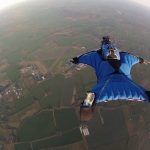Download links
How to install Soaring Through the Skies: The Thrill of Wingsuit Flying APK?
1. Tap the downloaded Soaring Through the Skies: The Thrill of Wingsuit Flying APK file.
2. Touch install.
3. Follow the steps on the screen.
Description
Wingsuit flying, a breathtaking blend of human ingenuity and the desire for flight, has a rich history that dates back to the early 20th century. The concept of gliding through the air with a suit designed to enhance lift and control can be traced to the pioneering efforts of aviators and inventors. One of the earliest recorded attempts at wingsuit design was made by the Russian inventor Gleb Kotelnikov in 1912, who created a rudimentary suit with fabric wings attached to the arms and legs.
Although Kotelnikov’s design was never successfully flown, it laid the groundwork for future innovations in the field. The evolution of wingsuit technology took a significant leap forward in the late 20th century, particularly with the advent of skydiving. In the 1990s, wingsuits began to gain popularity among skydivers who sought to extend their freefall time and experience a new dimension of aerial movement.
Pioneers like Patrick de Gayardon and Jari Kuosma developed more sophisticated designs that allowed for greater control and maneuverability. These early wingsuits featured larger surface areas and were constructed from lightweight materials, enabling pilots to glide longer distances and perform acrobatic maneuvers. As the sport grew, so did the technology, leading to the modern wingsuits we see today, which are engineered for optimal performance and safety.
Key Takeaways
- Wingsuit flying has a history dating back to the early 20th century, with designs evolving over time to modern technology.
- The physics of wingsuit flying involve understanding aerodynamics, lift, and drag to achieve the thrilling experience of soaring through the air.
- Becoming a skilled wingsuit pilot requires extensive training in skydiving, canopy control, and wingsuit flying techniques.
- Navigating the risks of wingsuit flying involves safety measures such as proper gear, weather conditions, and emergency procedures.
- Soaring through the skies in a wingsuit provides an exhilarating experience, with pilots describing the feeling as a combination of freedom and adrenaline rush.
- The future of wingsuit flying includes innovations in gear, technology, and safety measures to continue advancing the sport.
The Physics of Wingsuit Flying: Understanding the Mechanics Behind the Thrill
The Freefall State
When a wingsuit pilot leaps from an aircraft, they enter a freefall state where gravity exerts a downward force. However, unlike traditional skydiving, where the body falls straight down, a wingsuit pilot spreads their arms and legs to create a larger surface area.
Generating Lift
This configuration generates lift, allowing the pilot to glide horizontally while descending. The design of modern wingsuits incorporates airfoil principles similar to those found in aircraft wings. The suit’s fabric is shaped to create a pressure difference between the upper and lower surfaces, resulting in lift.
Control and Navigation
The angle of attack—how the suit is oriented relative to the oncoming airflow—plays a crucial role in determining how much lift is generated. Pilots can adjust their body position to optimize this angle, allowing for controlled turns and altitude management. The balance between lift and drag is essential; while lift propels the pilot forward, drag acts against this motion, slowing descent. Understanding these forces enables pilots to navigate their flight path with precision.
The Training and Preparation: How to Become a Skilled Wingsuit Pilot

Becoming a skilled wingsuit pilot requires extensive training and preparation, as it is not a sport for the faint-hearted. Aspiring wingsuit flyers typically start their journey with skydiving, accumulating a significant number of jumps before transitioning to wingsuit flying. Most experts recommend completing at least 100 jumps in various conditions to develop essential skills such as body control, situational awareness, and emergency procedures.
This foundational experience is critical for understanding how to manage freefall dynamics before adding the complexities of wingsuit flying. Once a skydiver has achieved the necessary jump experience, they can begin wingsuit training under the guidance of certified instructors. This training often includes ground school sessions that cover wingsuit aerodynamics, flight techniques, and safety protocols.
Pilots learn how to don and adjust their suits properly, as well as how to execute specific maneuvers such as turns and dives. Additionally, instructors emphasize the importance of pre-jump checks and emergency procedures, ensuring that pilots are well-prepared for any situation they may encounter during flight. The combination of theoretical knowledge and practical experience is vital for developing the confidence and skills needed to soar through the skies.
The Risks and Safety Measures: Navigating the Dangers of Wingsuit Flying
| Category | Risks | Safety Measures |
|---|---|---|
| Equipment | Malfunction of parachute or wingsuit | Regular maintenance and inspection of gear |
| Weather | Unpredictable wind patterns | Thoroughly checking weather conditions before flight |
| Physical Health | Physical strain on the body | Regular exercise and health check-ups |
| Training | Lack of proper training | Extensive training with experienced instructors |
Wingsuit flying is undeniably thrilling, but it also comes with inherent risks that require careful consideration and preparation. One of the primary dangers is the potential for collisions with terrain or other objects during flight. As pilots navigate through canyons or around cliffs, they must maintain situational awareness and make split-second decisions to avoid obstacles.
The high speeds involved—often exceeding 100 miles per hour—leave little room for error, making it essential for pilots to have a thorough understanding of their surroundings. To mitigate these risks, safety measures are paramount in wingsuit flying. Pilots are encouraged to conduct thorough pre-jump briefings that include discussions about weather conditions, landing zones, and potential hazards.
Many experienced wingsuit flyers also utilize tracking devices that allow them to communicate with ground support teams during their flights. Additionally, wearing appropriate safety gear such as helmets and parachutes designed specifically for wingsuit flying can significantly enhance safety. The use of specialized parachutes allows for more controlled landings, which is crucial given the unique dynamics of wingsuit descent.
The Thrill of the Experience: What It Feels Like to Soar Through the Skies in a Wingsuit
The experience of soaring through the skies in a wingsuit is often described as one of the most exhilarating sensations imaginable. As pilots leap from an aircraft, they are immediately enveloped by a rush of adrenaline that accompanies freefall. The initial moments are characterized by an intense feeling of weightlessness as they transition from vertical descent to horizontal flight.
Once stabilized in flight, pilots often report an overwhelming sense of connection with their environment. The wind rushing past their bodies creates an exhilarating sensation that heightens awareness and focus.
Many wingsuit flyers describe the experience as meditative; they become acutely aware of their body movements and how they interact with airflow. The ability to maneuver through canyons or over stunning landscapes adds an element of adventure that few other activities can match. Each flight becomes a personal journey where pilots can push their limits while enjoying breathtaking views from above.
The Future of Wingsuit Flying: Innovations and Advancements in the Sport

As wingsuit flying continues to evolve, innovations in technology promise to enhance both performance and safety in this thrilling sport. One area of development is in materials science; advancements in lightweight fabrics and composite materials are leading to more efficient designs that improve glide ratios and maneuverability. These innovations allow pilots to cover greater distances while maintaining control during flight.
Additionally, advancements in wearable technology are beginning to play a role in wingsuit flying. Pilots are increasingly using heads-up displays (HUDs) that provide real-time data on altitude, speed, and trajectory directly within their line of sight. This information can be invaluable for making informed decisions during flight and enhancing overall situational awareness.
Furthermore, ongoing research into aerodynamics may lead to new suit designs that optimize performance even further.
As wingsuit flying gains popularity, more training programs are being established worldwide, allowing newcomers to experience this exhilarating activity safely.
With continued advancements in technology and training methodologies, wingsuit flying is poised to attract a broader audience while maintaining its core values of adventure and exploration in the skies.
FAQs
What is wingsuit flying?
Wingsuit flying is a skydiving discipline where participants wear a special jumpsuit that adds surface area to the human body, enabling a significant increase in lift. This allows the participant to glide through the air at a slower descent rate than traditional skydiving.
How does a wingsuit work?
A wingsuit works by creating additional surface area with fabric between the arms and body, as well as between the legs. This increased surface area allows the participant to generate lift and glide through the air, rather than simply free-falling.
What are the risks of wingsuit flying?
Wingsuit flying carries inherent risks due to the high speeds and proximity to the ground or other objects. Accidents can occur due to collisions, loss of control, or failure to deploy the parachute in time. It is considered an extreme sport and should only be attempted by experienced skydivers.
What training is required for wingsuit flying?
To participate in wingsuit flying, individuals must first become experienced skydivers and obtain a skydiving license. Additional training specific to wingsuit flying is then required, including instruction on how to control the wingsuit and navigate safely.
Where can wingsuit flying be practiced?
Wingsuit flying is typically practiced at specialized drop zones or skydiving centers that have the appropriate facilities and safety measures in place. Certain locations may also offer specific wingsuit flying courses and events.





